

Traveling by way of the Isthmus of Panama, Aaron Lane arrived in California sometime prior to October of 1850. He soon found a location that he felt was promising for placer mining, and began working out of an established camp situated along Sutter Creek, some 30 miles southeasterly of Sacramento.
The mining camp, located in the verdant and beautiful Ione Valley, did not have an official name as yet, and the 1850 Federal Census simply called the entire region "Calaveras County and District." Eventually, with their usual flair for colorful terminology, the miners dubbed the site Bedbug, and later changed it several times, selecting such names as Scrabble and Freezeout. As time passed the community outgrew these frontier names, and it adopted the valley’s more euphonious name of Ione.
At the time of Lane’s arrival, Ione City was at its earliest stages of development. Only two years had passed since the first Americans entered the area, and, with the exception of one house built in 1848, permanent structures were just beginning to be erected.
Lane shared his new living quarters, the census records show, with another miner from New Hampshire, which is an indication he may have traveled to California with others from his home state. It was a common practice for people to emigrate in groups made up of family, friends and acquaintances.
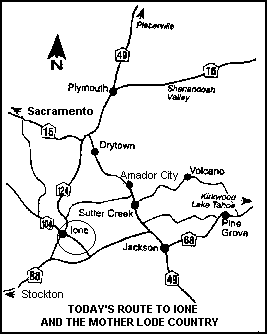
The records also show he had no personal or real property at that time. If he was like thousands of others in the region, he probably spent most of what money he had on transportation to the Pacific Coast.
LANE OPENS FIRST STORE IN IONE
The chances of earning a large sum of money from placer mining were remote, even for those who arrived as early as 1849 and 50. However, Lane himself had a degree of success, for within a few months he replenished his bankroll sufficiently to attempt a business venture.
In the spring of 1851 he opened the first store in Ione, according to Judge C. B. Swift in a history of the city written for the U. S. Centennial celebration. There are few records from this period of the area's history, so it cannot be said what kind of store this was -- whether it was located in a building or a tent, or simply in a wagon -- but it was the first of several commercial endeavors that Lane engaged in during his years in Ione.
The earliest documented reference to a store owned by him is from July of 1852, when Isaac Dickason sold to A. G. Lane a "Parcel of land and house, known as Dickason Store, lying in Ione Valley, on Sutter Creek...," together with a lot that was 100 foot square. The terms were $300 down and $300 due by November 1, 1852. This enterprise became known as the Ione Valley House. It was located on the south side of Main Street, near Buena Vista. The name of the business has the sound of a roadhouse, which means that it provided services much as an inn or tavern, although that would not preclude it from having supplies in stock.
At an early date Lane claimed 160 acres of rich agricultural land along Sutter Creek, in the lower part of Ione Valley. The property was registered at Benicia, at that time the state capital, on February 27, 1854, but it is likely that Lane possessed the land prior to that date. The "A. G. Lane Ranch" commenced, according to the deed, at "the S. E. corner of R. D. Stiles [Ranch]."
Judge Swift praised this area highly in his Centennial history. The wild oats were a half-inch thick, he said, and long enough for a fish pole; squashes grew to 250 pounds, and "the natural grasses, taller than horses or men, attest the unexampled fertility of the soil." Some in the community took advantage of the abundant forage by purchasing herds of cattle in Southern California and driving them to Ione Valley where they could be cheaply fattened and sold in the local markets.
BEGINS ANOTHER ENTERPRISE
As the town grew, Lane expanded his commercial interests. In 1855 he joined with John M. Wooster and Robert Reed in building the Vulcan Mill, which was the first brick gristmill in the valley. This was a water-powered mill, originally intended for grinding animal feed, but it was soon improved so that it could produce flour.

|
THE VULCAN MILL AS IT APPEARED YEARS LATER UNDER NEW OWNERSHIP. ORIGINAL BRICK STRUCTURE IN UPPER LEFT-HAND CORNER. |
Lane's partners were both very early pioneers of Ione as well; Wooster built the first house made of hewed logs, and in 1853 Reed provided a house for the first school. They were also men of prominence in the community. Wooster’s influence was such that the town at one time was named after him. One source credits John Wooster as being one of the first white men to see the giant redwoods of the Sierra Nevadas, and states that the name J. M. Wooster, with the date June 1850, was found carved on the trunk of one of the trees in the Calaveras North Grove.
INDICTED FOR WILLFUL DAMAGE
The same year the partners began the project on the mill, Aaron was indicted for willfully damaging a public structure that he had also had a part in building. The Amador County Archives has in its files the remains of a dispute that arose between A. G. Lane and the officials of Amador shortly after the county's formation.
Amador was created in June of 1854 from that portion of Calaveras County lying northerly of the Mokelumne River. From bills Lane submitted in late 1855, it appears the dispute began in January of the previous year. He backdated the bills to January 1, 1854, and signed himself as the road supervisor for a bridge constructed over Sutter Creek. This meant the bridge was built when Ione was still part of Calaveras County, and it is probable that the change in jurisdiction was the source of the problem.
By January of 1855 Lane had still not received payment. His frustration over the ineffectiveness of his appeals to the Amador officials finally turned to anger, and one day he went out and proceeded to dismantle the bridge. This rash act resulted in an indictment by the Amador County grand jury, which charged him with the misdemeanor of obstructing and injuring a public bridge:
Committed as follows the said A. G. Lane on or about the 31st day of January AD 1855 at the County of Amador did unlawfully, willfully, and maliciously and with the intent to injure and obstruct the same take off and carry away certain planks from a Public Bridge situate near Ione City and across Sutter Creek. |
Lane's action may have provided him a certain amount of satisfaction, but there was still the issue of unpaid vouchers, so he continued to press for payment. The bills previously referred to are dated in November of 1855, which shows that Lane had not been reimbursed, or at least not completely so, by that late date.
One invoice, dated November 12th, has a handwritten note by a deputy to the County Clerk stating "not allowed." This suggests that, after the passage of eighteen months since the creation of the new county and 23 months since the construction of the bridge, Amador officials still had not recognized the obligations of their predecessors, with Lane suffering as a result. If he ever did recover his claim it is not in the records, but apparently the grand jury indictment was dismissed, for there is no indication the charges were ever pursued.
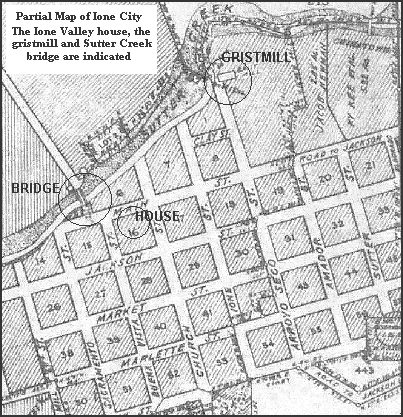
CITIZENS BATTLE FOR LAND OWNERSHIP
There were other problems that required Lane's attention besides his dispute with Amador County. The citizens of Ione had recently entered into a legal battle to save their rights to land ownership in the valley. In 1852 a claim had been filed in the General Land Office to the effect that eleven leagues of a Mexican grant known as the Arroyo Seco had been ceded to Teodocio Yerba by Governor Alvarado in 1840.
It was only in 1853, when a committee met in the state capital at Benicia to discuss the establishment of Amador County with the Legislature, that the towns-people of Ione accidentally discovered their property rights had been challenged. A group called the Settler's League was formed to contest the grant. As a substantial citizen of the town, Lane was chosen to be a member of the League, and served as one of a committee of three to select the lawyers that would represent the landowners.
On February 27, 1855, the California Land Commission, which was appointed by the federal government to review the validity of Mexican claims, rejected the Arroyo Seco claim. However, this ruling was overturned the following year in the United States District Court. The case was appealed to the Supreme Court, which, for reasons that historian Swift was unable to fathom, dismissed the suit in May 1858, thus recognizing the successors of the Yerba claim.
This was a painful decision for the settlers of Ione Valley, and in 1865 many of those who were unable, or unwilling, to purchase their land from the new owners were forcibly evicted by troops. Lane himself, though, was not directly affected by the court's findings, as he had long since moved to Southern California by the time action was taken on the suit.
AARON IS A SOLID CITIZEN
During his years in Ione, Aaron Lane had attained a high standing in the community, which is borne out by the fact that he signed as surety for bonds posted by some of the officers of the town. In August of 1855, Lane was one of six signatories guaranteeing the conduct of L. G. Lyon as Sheriff of Amador County, in the sum of $25,000.
Just a few weeks later, he and another man put up a bond of $5,000 for Justice of the Peace N. C. F. Lane (whether this was a relative is unknown, but if he was, it was a distant relationship). The 1855 Amador County tax rolls list A. G. Lane as having $350 in personal property and $1,500 in land, for a total assessment of $1,850, establishing him as a solid citizen.
Eighteen fifty-five was the peak of Lane's years in Ione Valley -- he took part in erecting a great brick structure, assured bonds for the town's leading citizens, and sat in on the decision making for important community affairs -- but trouble was not far away.
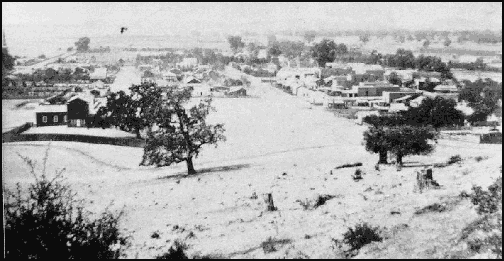
|
VIEW OF IONE CITY NOT LONG AFTER LANE'S DEPARTURE. JACKSON STREET IS IN CENTER OF PHOTOGRAPH. MAIN STREET IS THE NEXT ONE TO THE RIGHT, AMIDST THE BUSINESS BUILDINGS. THE GRISTMILL IS JUST OUTSIDE THE PICTURE TO THE RIGHT, AND IONE VALLEY IS IN THE BACKGROUND. |
FINANCIAL PROBLEMS BEGIN
On April 19, 1856, he and a man named Christian Leininger were sued in the Fifth Judicial Court by Aaron Cohen for failure to pay a debt of $500. The answer to the charges acknowledges the note, but states the plaintiff was not the lawful holder and that the amount was incorrect for various reasons. The answer also refers to "labor & services," indicating that the debt was connected to construction, probably having to do with work on the gristmill.
Lane and his partners were having trouble with finances on the mill, which is further evidenced by the filing of a mechanic's lien by contractor S. C. Coombs Co. against Lane, Reed and Wooster, for failure to pay for lime used in building the brick structure.
Lane apparently had notes being called in by others as well. Less than a month prior to the filing of the suit, he had raised $500 by selling off a piece of property on Main Street. He must have been desperate for cash at this time, because on April 16th he borrowed $1,061.47 from a Mr. Patrick Lynsky, at the rate of two and one-half percent per month. Although this rate was common at the time, it could lead to financial ruin if not paid off quickly.
Even with the sale of his property and the loan he had gotten, he still did not have adequate funds to meet his financial commitments. During the June term, the court found for Aaron Cohen and ordered the sheriff to sell Lane's goods and chattels, and if that proved insufficient, to sell his real estate to make good the debt. On August 16th, the sheriff held an auction at the courthouse in Jackson, and sold Ione Valley House to Aaron Cohen for $475. Lane was given six months to redeem the property.
In June of 1857 Lane was again sued, this time by Lynsky for foreclosure of a mortgage. At the same court hearing one of Lane's partners in the flour mill, John Wooster, was also sued for foreclosure of a mortgage. The District Court found in favor of Lynsky, and to satisfy the judgment the Ione Valley House was put up for auction a second time, so apparently in the interim months Lane had somehow been able to regain ownership of the property.
Aaron's financial world had collapsed, and he was forced to sell his 160-acre ranch in July of 1857, for which he received $1,000. He used most of that to pay his debts -- he was now virtually broke.
It is well that when Judge Swift spoke of the earliest days in Ione, he remembered A. G. Lane for his successes and overlooked his failures. After all, Lane had provided many of the firsts for the community: the first store, the first inn, and was a partner in the first brick flour mill, all the while enjoying the respect and admiration of the townspeople.
Ione Valley had been his home for seven years, so when the day came that he made the decision to leave, it must have been difficult for him indeed. At the threshold of middle age, and suffering from the malaria he had contracted in Mexico, he packed up what few belongings he still owned and headed for Southern California to start over again.

RELOCATES IN SAN BERNARDINO
Lane arrived in the town of San Bernardino in the latter part of 1857, no doubt attracted by the cheap land being offered as a result of hundreds of Mormons leaving the area that same year to return to Utah. However, his capital was so limited that the only way he could take advantage of the bargain prices was to find someone who was willing to go into partnership on the purchase.
On January 16, 1858, he joined with a Mr. O. J. Shattuck in buying 20 acres of farmland from the company of Lyman, Rich and Hanks, the Mormon proprietors of Rancho San Bernardino. He and Shattuck paid $200 for the lot, which fronted what is now Mill Street, almost a mile east of Tippecanoe Avenue.
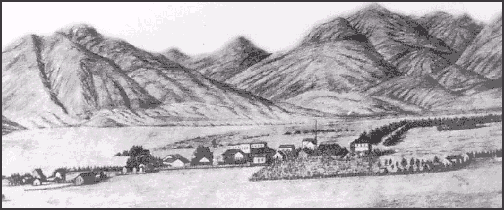
The property was located in a rapidly developing area along the Santa Ana River known as the Timber Settlement, so named because of the many large cottonwood trees growing there. Due to high ground water, the land was usually moist; grasses, fruit trees, grapevines and deep-rooted plants grew without irrigation. In order that farmers might grow corn and other garden crops, and because of a very dry year, two earthen canals were dug in 1857. The canals provided irrigation to the north side of the Santa Ana River, and were known as the North Ditch and the Timber, or South, Ditch.
Lane was one of the earlier land buyers in the Timber Settlement, but he was shortly followed by others. About five weeks after his purchase a new neighbor moved in on the west, a 58-year-old German emigrant from Hanover by the name of Francis Goll, and in May, Edwin Hueston Thomas bought the 20-acre parcel adjacent on the east.
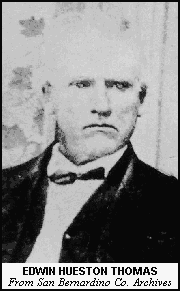
Thomas had been elected in February of 1858 to the office of County Supervisor, filling the First District seat vacated in December by Mormon Daniel Stark. Thomas originally settled in the west part of town, but following the election he made the decision to move to the Timber Settlement, where he began adding to his holdings until he and his sons owned several 20-acre parcels in the immediate vicinity.
ROAD OVERSEER
Within the same month that Aaron Lane and Ed Thomas became next-door neighbors, Thomas had Lane appointed as a road overseer. According to the minutes of the May 31, 1858, meeting of the Board of Supervisors, it was ordered that "Mr. Lane be and is here-by appointed overseer of the Road leading from the Santa Ana by the house of Mr. E. H. Thomas running north and south Thence west to the mill of Mr. H. E. Parrish." This was the main road leading east from the town of San Bernardino to the Timber Settlement and then south to Old San Bernardino, also known as the Mission District, which is situated south of the Santa Ana River on what is now Mission Road, east of Mountain View Avenue.
The position of road overseer was a responsible one. The San Bernardino Guardian published a description of the job, which entailed the following duties:
|
.....1.
Take charge of the public highways
within their respective districts; |
For performing these duties, the road overseer would receive three dollars for each day's service, which would be audited and ordered paid by the Board of Supervisors.
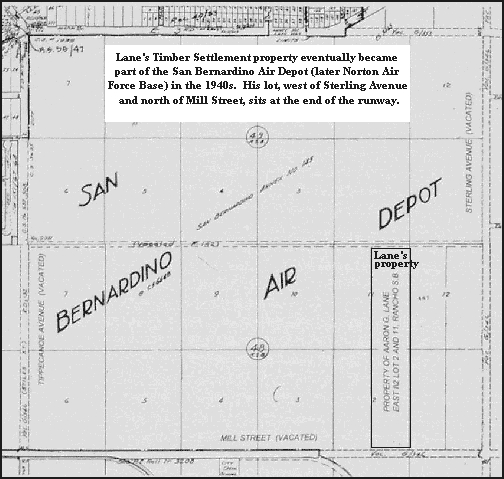
POOR HEALTH FORCES MOVE TO DESERT
Lane's prospects looked favorable. He had some cash coming in from his job as road overseer, and the prime farmland in the Timber Settlement presented excellent opportunities for him. However, his ambitions for rebuilding a life for himself in San Bernardino were not to be realized. His health was showing no signs of improvement in the valley climate, so he decided he would have to give up his interests in town and move to the drier climate of the desert.
He took steps to conclude his affairs in the valley in preparation for his move. On November 9, 1858, he borrowed $110 on the Timber Settlement land from a Mr. Joseph Lane, presumably to pay for his partner's half-interest in it. The loan was then transferred to Edwin H. Thomas, whose son, Elijah, subsequently assumed title to the property in January 1859.
The desert climate would prove to be very beneficial to Lane, whose health had failed to the point of emaciation. The extent of his illness when he first came to the area is shown by the statements of Judge A. D. Boren and Dr. J. C. Peacock. These two distinguished citizens of San Bernardino testified in Lane's behalf when he later applied in the 1870s for reinstatement of his Mexican War disability pension, which he had allowed to lapse in 1852.
Judge Boren stated that he had known Lane since the latter's arrival in 1857, and that "some times said Lane has appeared to be in very poor health, and at other times he appeared better." Dr. Peacock wrote a lengthy two-page letter, in which he stated, "When I first knew said Aaron G. Lane he was greatly emaciated and much out of health, suffering much from Billious [sic] disease -- Fever and Ague -- and from the long use of calomel from which he had lost his teeth."
Lane was the first of many thousands to come to the desert for health purposes. Others were to follow decades later at nearly the exact same spot. "In desert California," author John Baur wrote, "far from the ocean and its atmospheric effects, tuberculars found the dry air that so often proved beneficial to them." He stated that in the 1880s, a small colony of Angelenos settled on the Mojave River at Oro Grande for health reasons, and that several Southern California doctors pioneered there, but "poor housing and faulty transportation, the ever-present check on wide-scale health seeking, prevented larger numbers from following their example."
It was in this favorable climate that Aaron eventually was able to make a new life for himself. Since he had operated a roadhouse in Ione, he took advantage of his experience and established a way station on the Mojave for the purpose of supplying food and provisions to travelers on the desert.
The land he chose for his enterprise was situated at the upper crossing of the Mojave River, a strategic location for an outpost. Over the years he would thrive and prosper in the desert wilderness, thanks to his improved health and the trade he derived from the increase of traffic on the road along the river.

 PAGE
1|
2|
3|
4|
5|
6|
7|
8|
9|
10|
11|
12
PAGE
1|
2|
3|
4|
5|
6|
7|
8|
9|
10|
11|
12

